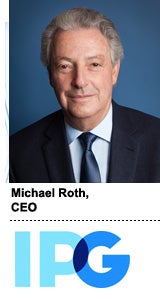Spending cuts in the CPG sector had a negative impact on revenue growth at IPG this past half year.
The holding company saw revenue decrease in both Q2 and H1 at -1.7% to $1.9 billion and -0.6% to $3.6 billion, respectively, the company announced on its earnings call Tuesday.
Growth at Mediabrands and McCann Worldgroup were “offset by an unusually soft tech and telecom sector along with slow growth in financial services and significant cuts in packaged goods,” said IPG CEO Michael Roth.
While the CPG sector only makes up 10% of IPG’s revenue, it still had a “disproportionate negative impact on the quarter,” dragging revenue down by 0.8%, Roth said.
“We think our clients are overreacting, frankly, in their cuts,” he said. “CPGs are going to have to spend dollars to maintain market share.”
While Roth attributed slowdowns in telecom, tech and financial services to client losses like USAA, TD Bank and Sprint, the packaged goods sector is struggling with disruption from digitally native competitors and competition with cheaper private labels from retailers.
In order to cut costs and remain profitable, CPGs are adopting zero-based budgeting models, reducing media spend and consolidating their agency rosters. It’s an issue affecting the entire agency industry, Roth said.
“All of us are contending with significant pressure from our consumer goods clients,” he said. “The trend is not new, but reductions intensified in Q2.”
While Roth said IPG doesn’t see a big spending push from consumer goods this year, he’s confident the group can benefit from consolidation by winning new business from existing clients.
“A lot of these big clients have thousands of agencies all over the world,” he said. “We’re in very good stay with most of our clients and therefore when they’re looking to consolidate local agencies, it makes sense that we take on that work.”
And as the conversation with CPGs changes from one of advertising to business transformation, IPG will leverage data and analytics to inform media and creative and help CPGs “get back in favor with the consumer,” Roth said.
“The only way to deal with it is to focus on their brands,” he said. “If it’s just price, how can we show the value of the brand? We can make a difference in terms of insights.”
As these issues become more central to agency work, IPG will set up more business transformation and consulting practices across the group, Roth said.
In addition to struggles facing the CPG sector, Roth attributed the weak half to slowdowns in project-based work, much of which is either in digital or PR.
“Our digital projects are becoming much larger in scope,” Roth said. “When you don’t have large projects to offset that, it gives us a much choppier result on a quarter-to-quarter basis.”
To meet the low end of its 3-4% growth expectations for the year, IPG will focus on growing business with its top 20 clients. But political gridlock and economic uncertainty in the US, where IPG has 60% of its business, could affect client willingness to spend.
“We need stronger growth in H2, but we’re not starting from a zero base in the US,” Roth said. “Our US business is very solid and should turn around a bit, particularly on the project side, in the second half.”














